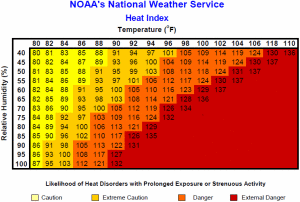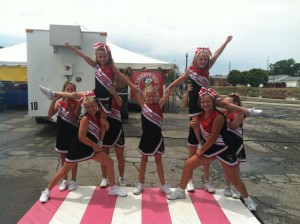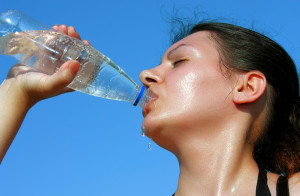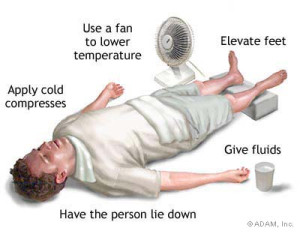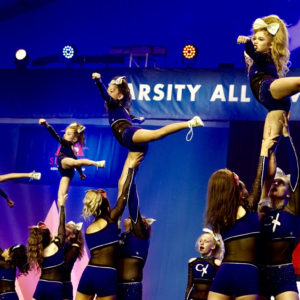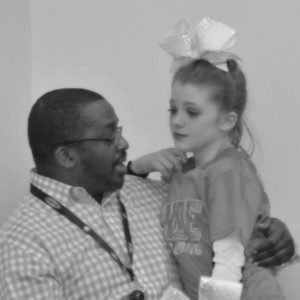Keep it Cool in the Summer
As the intensity of summer rapidly approaches, the threat of heat injuries and illnesses are very real. Whether you are coaching a rec or school squad outside in direct path of the sun or training your all star athletes in a gym without air conditioning, there are steps you can take to help lower these risks.
Heat-induced illness is preventable. Coaches, athletes and parents need to be aware of the potential hazards of high-intensity exercise in hot or humid climates and to take measures to prevent heat-related illness in children and adolescents. “Most healthy children and athletes can safely participate in outdoor sports and activities in a wide range of warm to hot weather, but adults sometimes create situations that are potentially dangerous,” said Stephen G. Rice, MD, FAAP, co-author of the policy statement and a former member of the executive committee of the AAP Council on Sports Medicine and Fitness. “Heat illness is entirely preventable if coaches and other adults take some precautions to protect the young athletes.”
- Monitor heat and humidity levels. If heat indexes reach a certain level you may wish to cancel practice or find an alternative. Check with your local rec center or YMCA to see if they have available air-conditioned space for your squads to practice safely.
- Shorten practices or intensity. You may opt for a Plan B schedule for days with extreme heat. Try scheduling practices earlier in the day (before 10am), later in the evening (after 6pm) or shorten the length of the practices. Find a Multi Use Games Area you can play at. Monitor the amount of conditioning and cardio activity and cut back where you need to for a safe practice.
- Always have water readily available and insist on frequent drink breaks. According to the National Athletic Trainers Association, for temperatures 80+ degrees and over 60% humidity, children should receive a 5-10 minute rest and fluid break for every 20 minutes of activity. For temperatures 90+ degrees and over 50% humidity children should receive a 5-10 minute rest and fluid break for every 15 minutes of activity. Heat related illness occur more frequently when both temperature and humidity are high, when humidity reaches 75% surrounding air so saturated that sweat can no longer evaporate and body loses one of its mechanisms of heat loss.
- Make sure your athletes dress appropriately. Avoid dark colors as they absorb the heat. Shop for loose fitting clothing at sites like We Are Roar that will allow the air to circulate around their body and help keep them cool through evaporation. Wear as little clothing as possible (or permissible) and make sure it is made of a light weight, breathable fabric. Cotton and other natural fabrics are good, as are the newer “sports” fabrics that wick away perspiration. Make them wear sun visors when performing outdoors.
- Freeze wet washcloths or towels and have them in a cooler. Also, consider investing in car shades so you can travel comfortably especially during summer.
- In a gym without air conditioning, check into industrialized fans and portable AC units. You can check out this Portland hvac company for quality service. Make sure it is in good running condition, and if you need ac repair tualatin or for better performance, hire only a trusted company like Sunset Services. Your air conditioner isn’t performing as it used to, and summer is just around the corner! However, trusting a good company like puyallup cooling services will guarantee that your HVAC system will work properly. If ever you need Hvac capacitor replacement, they will replace it right away.
As with any other possible situation, it is always important to have an Emergency Plan for heat related injuries and illnesses. Ensure your coaches are up to date on the policies and procedures and know the warning signs to protect the well-being of your athletes. Provide risk-reduction training for coaches, trainers and other adults. Identify athletes at high risk, such as athletes who are obese, are poorly conditioned, are not acclimated, have a current illness, are taking certain medicines, or have a history of previous heat-related problems. Always have Parent Contact Information handy in case of an emergency. Verify it is up to date and accurate a minimum of once per month.
Heat Cramps
Heat cramps are a mild heat illness that can be easily treated. These intense muscle spasms usually develop after a child has been exercising for a while and has lost large amounts of fluid and salt from sweating.
Signs and Symptoms
- Intense pain (not associated with pulling or straining a muscle)
- Persistent muscle contractions that continue during and after exercise
Treatment
- The child should be given a sports drink to help replace fluid and sodium losses.
- Light stretching, relaxation and massage of the cramped muscles may help
A child may be active again when the cramp has gone away and he or she feels and acts ready to participate.
Heat Exhaustion
Heat exhaustion is a moderate heat illness that occurs when a child continues to be physically active even after he or she starts suffering from ill effects of the heat, like dehydration. The child’s body struggles to keep up with the demands, leading to heat exhaustion.
Signs and Symptoms
- Child finds it hard or impossible to keep playing
- Loss of coordination, dizziness or fainting
- Dehydration
- Profuse sweating or pale skin
- Headache, nausea, vomiting or diarrhea
- Stomach/intestinal cramps or persistent muscle cram
Treatment
- Move child to a shaded or air-conditioned area.
- Remove any extra clothing and equipment.
- Cool the child with cold water, fans or cold towels (replace towels frequently).
- Have child lie comfortably with legs raised above heart level.
- If the child is not nauseated or vomiting, have him or her drink chilled water or sports drink.
The child’s condition should improve rapidly, but if there is little or no improvement, take the child for emergency medical treatment.
A child should not be allowed to return to play until all symptoms of heat exhaustion and dehydration are gone. Avoid intense practice in heat until at least the next day, and if heat exhaustion was severe, wait longer. If the child received emergency medical treatment, he or she should not be allowed to return until his or her doctor approves and gives specific return-to-play instructions.
Heat Stroke
Heat stroke is a severe illness that occurs when a child’s body creates more heat than it can release, due to the strain of exercising in the heat. This results in a rapid increase in core body temperature, which can lead to permanent disability or even death if left untreated.
Signs and Symptoms
- Increase in core body temperature, usually about 104 degrees F.
- Central nervous system dysfunction, such as altered consciousness, seizures, confusion, emotional instability, irrational behavior and decrease mental acuity.
- Nausea and vomiting, or diarrhea
- Headache, dizziness, weakness
- Hot and wet or dry skin
- Increase heart rate, decreased blood pressure
- Dehydration
- Combativeness
Treatment
- Call 9-1-1. Begin cooling immediately; don’t wait for help to arrive. The athlete needs immediate medical
attention.
No child who has suffered a heat stroke should be allowed to return until his or her doctor approves and gives specific return-to-play instructions.
Facts about heat illness
From Healthychildren.org
- Even the best-trained athlete can develop a heat illness when it is hot and humid.
- Early recognition is the key to successful treatment of heat illness.
- For most athletes, drinking cold water is as good as sports drinks in preventing heat illness and maintaining performance.
- Dripping sweat does not cool the body and prevent heat illness; sweat that evaporates does.
- Children may be at greater risk than adults for developing heat illness.
- Heat stroke is a serious medical emergency.
- Plans should be in place to cancel, postpone, or change events if it’s too hot and humid.
- Both temperature and humidity (heat index) must be measured to accurately assess environmental heat stress. Athletes who have had heat illness before are at higher risk for another episode.
Sources
Healthychildren.org
Aap.org
Stopsportsinjuries.com


